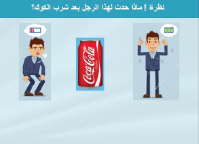Lost In Translation?
As adults, most of us have a hard time recalling early childhood memories. But some of them are hardwired into your system because they made such an impact. At least that’s what the neuroscientists say. Well – I have one such memory – it is of this joke I use to share with all my friends. Admittedly, it isn’t a great joke, but it used to really crack me up.
The joke is about an ad for Coke. Look at the picture below; it speaks a thousand words.

You can clearly see from the ad that Coke gives you energy. The campaign was a massive hit all over the world, except – for some strange reason – in Arab countries. Can you guess the reason why? Look at the version of the ad that was placed there.

That’s right! Arabic speakers read from right to left. From their perspective, a healthy man drinks Coke and becomes weak. No wonder the campaign did not work. This was m favorite joke back when I was young because not many of my friends knew that Arabic was read from right to the left.
The ad was completely ‚LOST IN TRANSLATION‘. While the text was translated correctly, the graphic was not localized to suit the locals.
Nelson Mandela once said, „If you talk to a man in a language he understands, that goes to his head. If you talk to him in his own language, that goes to his heart.“ Today, translation and localization permeates every industry and sector. But often factors like cost, work load and time hinder products from being properly localized. Confused yet? So was I. Until recently, I used to think translation and localization was the same thing. This is not the case – they are similar and related, yet different.
Perhaps a definition of the two can give us a better understanding.
Translation can be defined as the process of changing original (source) language content such as text, multimedia, eBooks, or apps into a different (target) language by simply substituting words from one language to another – in context. The Globalization and Localization Association (GALA) defines localization as the process of adapting a product or content to a specific locale. The goal is to provide a product with the look and feel of having been created for the target market to eliminate or minimize local sensitivities.
Localization – as the name suggests – is about being local. A product being considered or recognized as local may vary across geographies. But these differences can be categorized into activity, complexity and adaptation.
Activity in Localization involves more than the act of just translation. It refers to understanding and incorporating the culture, local sensitives, ideas, beliefs, styles, patterns, norms, superstitions, etc. This clarifies why localization is so critical to marketing materials and advertising campaigns.
Complexity in localization relates to cultural and functional factors. Cultural differences can be a combination of color, shapes, styles, visuals, graphics, gestures, superstitions, humor, symbols, etiquettes, relationships, religion, and social values. Functional differences include date and time formats, phone number and address syntax, product details and description as well as local legislation.
Adaptation simply means adjusting the content (or marketing) mix to best satisfy consumer needs and wants.

The reason why industries should opt for localization along with translation can be summarized as follows
It’s all about the customers – „Loyal customers, they don’t just come back, they don’t simply recommend you, they insist that their friends do business with you.“ ~ Chip Bell
Localizing a product allows it to properly serve the customers‘ best interest, thereby gaining customer support, trust and commitment. This avoids the failure of literal translation which in the best case falls flat, and in the worst case leads to offense in a target locale. As every business knows, a satisfied customer is the best advertisement.
Think global, act local – “If you think small, your world will be small. If you think big, your world will be big.” ~ Paulo Coelho
The time that is put into understanding the customer needs, language, culture, perceptions, seasonal requirements, and more can be mountainous. The good news is that once a product is localized, you have the advantage of being on the same page as your international customers. They will be comfortable with your products, finding them reliable and dependable. Like the old saying goes; slow and steady wins the race. It will take longer than just translating, but is a sure route to success.
Risk Management – „What you don’t know can kill your project.“ ~ Bruce Pittman
Moving abroad, I came to realize that my name has plethora of pronunciations and meaning in different parts of the world. How strange! When my parents named me, they chose a name which means something spectacular in my native language. Of course, we don’t expect our parents to name us by considering what our name would mean across the globe. Now there is pretty much nothing I can do about it. Either I change my name or deal with it.
We can see similar issues in marketing and advertising. Many companies name their products based on their native markets, but when launching globally, this could have unexpected results. Let’s consider Ford Fiera; ‚fiera‘ means ‚beast‘ in Spanish.
It’s absolutely necessary to consider the impact (nor non-impact) of product names on local brand image. This will save unnecessary controversy, embarrassment, and ultimately lost ROI. Product names must be considered in local markets, including potential copyright infringement.
Cut down on costs – „The fashion of the world is to avoid cost, and you encounter it.“ ~ William Shakespeare.
The earlier you localize, the better. Postponement will only create problems downstream like expensive rework or recalls.
In conclusion, Translation and Localization are two sides of a coin, complementing each other. Without localization, content and products will not be successful in global markets. Why jeopardize it when all it takes is just an extra mile to ensure excellence.

